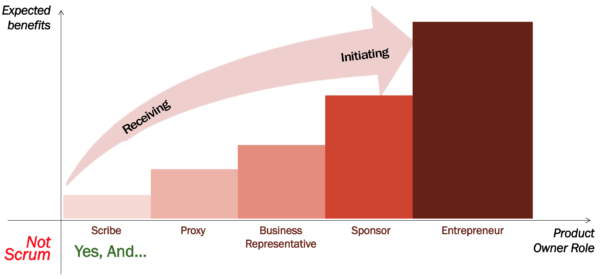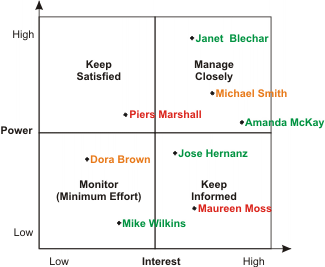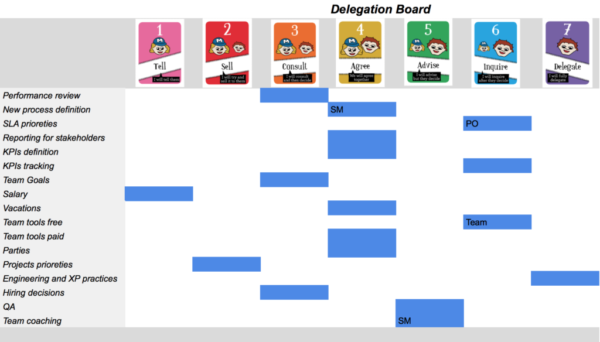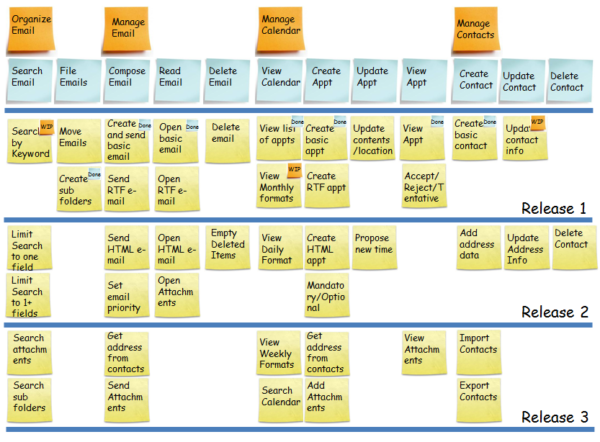— December 2, 2017
In this blog, we’ll cover some tips and tools for starting Product Owners, to help you in your new role. The Product Owner role is a brand new role in many organizations and it’s a role which can’t be compared to traditional roles, such as project managers or business analysts.
A Product Owner in it’s most beneficial form acts like an Entrepreneur, like a ‘mini-CEO’. The Product Owner is someone who really ‘owns’ the product. This is something quite different from a project manager (PM) or business analyst (BA) role, where ‘the business’ typically ‘owns’ the product and where the PM or BA act more like a proxy between the (project) sponsor and the supplier (IT for example). The Product Owner as an Entrepreneur owns the Product, the Product Vision, the Product Roadmap and the Products’ budget. So ideally, the Product Owner is profit-and-loss accountable for the Product.

What I see in many organizations, however, is that the Product Owner role is implemented on a ‘lower’ level of the Product Owner Maturity model. So, most Product Owners I encounter are actually Scribes, Proxy’s or Business Representatives. In this blog, we’ll cover some tips for the starting Product Owner. In another blog (which will follow soon) we’ll cover tips for more advanced Product Owners (on the Entrepreneurial level).
Okay, so you just started as a Product Owner, what should be your first steps? Below I’ve defined some important steps you should take as a Product Owner.
Important remark:
Beware that these steps aren’t necessarily sequential. Although I found it helpful to perform the following steps in this order, you might want to change some stuff around of course. Don’t misuse these steps to prevent you from getting started! The purpose of these steps is not to perform them all, before you ever start your first Sprint. You’ll want to start your first Sprint as soon as possible, deliver a done increment and work on these steps as you’re learning new things.
Step 1: Form the Scrum Team & collaborate with them.
As a Scrum Product Owner, you only need one thing in order to get started, which is your Scrum Team! You’ll need someone to help you guide the process, coach you and your team and to solve impediments, which is your Scrum Master. And of course, you’ll need some people to develop and maintain the product, which are the people in your Development Team. Your first step as a Product Owner should therefore be to get you yourself a Scrum Team. In all the following steps, make sure you collaborate with them to increase your chances for success, but also to get the team enthusiastic, motivated, involved and to use their knowledge and experiences.
Step 2: Get clarity on the (product) vision.
Many Product Owners start as scribes, proxy’s or business representatives on the Product Owner maturity model. Ideally, you’d be the person who defines the vision, but what I see typically is that starting Product Owners are appointed in their role by the organization and typically do not have the mandate to decide on the (product) vision yet. So therefore, you should get clarity on the (product) vision, by talking to your stakeholders (and your Scrum Team).
There are many tools/techniques that could help you in defining the product vision, take a look at some of these techniques (business model canvas, product vision board, product canvas, value proposition design) and collaborate with your stakeholders, Scrum Master and Development Team to create them. Mind yourself, it would require a perfect and non-changing world to get your first vision board right. Besides that, since the world is changing continuously, you’ll probably have to pivot or change things around over time anyway. So, don’t try to get it perfect! Try to create an inspiring vision, that helps people to focus. That’s an important part of your job as a Product Owner, create focus.
Step 3: Get clarity on your stakeholders and how to engage them.
One of your responsibilities as a Product Owner, is to manage (or engage with) your stakeholders (including customers). You should make sure that the right people are sitting together with you as a Product Owner, to decide on the product vision, product roadmap, value for the product and to make choices together. As a Product Owner, you should involve the right stakeholders to maximize value delivered to your customers.

A tool I’ve used very often is the ‘stakeholder map’. It’s a nice tool to gain insight in the stakeholder field and to decide how to manage them / engage with them. In the stakeholder map, you can plot your stakeholders on two axes; 1) their (formal/informal) power and 2) their interest in the product. Based on their power and interest, you can define how to engage with the different groups of stakeholders. So what I often did, was that I designed a stakeholder map and based on the mapping, I designed my communication strategy for the different groups of stakeholders. Although I may not have to mention this, you would of course like spend most of your time on your most important stakeholders! So design your communication strategy based on this principle.
Step 4: Get clarity on your mandate (including your team and budget).
So, now that you know your most important stakeholders, involve them to define your mandate. Maybe you’ve been appointed by a sponsor, management or the business as a Product Owner, but what does this mean for them? What are your responsibilities? And what is the mandate that comes with these responsibilities?
Something I’ve used often to get clarity on the Product Owners’ mandate, is Jurgen Appelo’s (author of Management 3.0) Delegation Poker. There are quite some examples of Delegation Boards / Delegation Poker that can be found on the internet, also see the following example. There are some aspects that I always like to get clarity on (amongst lots of others), which are:
- Who is needed to define, change or pivot the product vision?
- Who is needed to define, change, pivot or remove business goals?
- Who is needed to add, define, change or remove items from the Product roadmap?
- Who is needed to add, define, change or remove items from the Product Backlog?
- Who is needed to add, change or remove people from the Scrum Team?

Step 5: Determine what ‘value’ is/means for your product.
How to define and measure value is something that is context-dependent. This may be totally different depending on your product, branche, type of product, product lifecycle phase, etc, etc. Therefore, you should define together with your (most important) stakeholders, what you consider as ‘value’. What is ‘valuable’ for the product? What is valuable for your customers? What is valuable for the processes you’re supporting? Based on how you define value for your product, you can also decide how you will measure value for the product.
Please remember, what value is for your product is context dependent. However, what value is, is also time-dependent! What value is for your product and how to measure it, may change over time.
Step 6: Create a (goal-oriented) (product) roadmap.
Now that you’ve defined what value is for your product and how to measure value, it’s a good time to translate this into a goal-oriented product roadmap (also see this blog for some tips about roadmaps). I like the goal-oriented roadmap a lot, since it is focussed on value (goals) first and features later. A lot of Product Owners fall into the trap of maximizing the teams’ output. Your goal should however be to maximize outcome. So, start by focussing on goals first! Define a couple of goals for the shorter term (next Sprint, this month, next month) and for the longer term (this quarter, next quarter, this year). Ordering and managing your Product Backlog will become much easier if you are clear on your goals.
Step 7: Create a story map for the product.

The next step would be to create a story map, together with some of your stakeholders and your Development Team. The story mapping technique is an awesome way to brainstorm, gain insights and get a picture of the product you are creating.
Step 8: Co-create the Sprint Goal & the Sprints’ plan.
Now that you’ve created your roadmap and story map, it’s time to design a Sprint Goal. The Sprint Goal has been very helpful for me in the past, because it provides the Scrum Team with a lot more focus. Focus is not only one of the core values of the Scrum Framework, it also makes a huge difference for the performance of the Development Team, and herewith also for the amount of business and customer value you can deliver for your product.
What I used to do as a Product Owner, was to create a ‘concept’ Sprint Goal before the Sprint Planning, with which the Scrum Master assisted me by asking lots of questions and by brainstorming together. The reason I’m calling it a ‘concept’ is because the Sprint Goal is being created during the Sprint Planning, together with the whole Scrum Team. Personally, I always liked to start the Sprint Planning with a goal in mind, to reshape that goal with the Development Team and then to move on to the other aspects of the Sprint Planning meeting.
Step 9: Keep collaborating with your Scrum Team and stakeholders.
While Sprinting, and while regularly delivering done product increments, the most important thing for you to do as a Product Owner, is to keep collaborating with your Scrum Team and your stakeholders. Support the Development Team by hosting refinement sessions, explaining the product vision, goals, roadmap and Product Backlog items. Support them by making items small, clear and valuable. Support them in gathering feedback from customers and users, etc.
Also keep collaborating with your stakeholders. Make sure to spend the most amount of your time on your most important stakeholders. Update your stakeholder map once in a while. Evaluate if your communication strategy is still working. And most important, make sure you get feedback early and often, so that you can maximize the value delivered every Sprint, again and again!
So that’s it! 9 Tips for starting Product Owners. I hope this was useful for you!
Business & Finance Articles on Business 2 Community
(76)
Report Post






